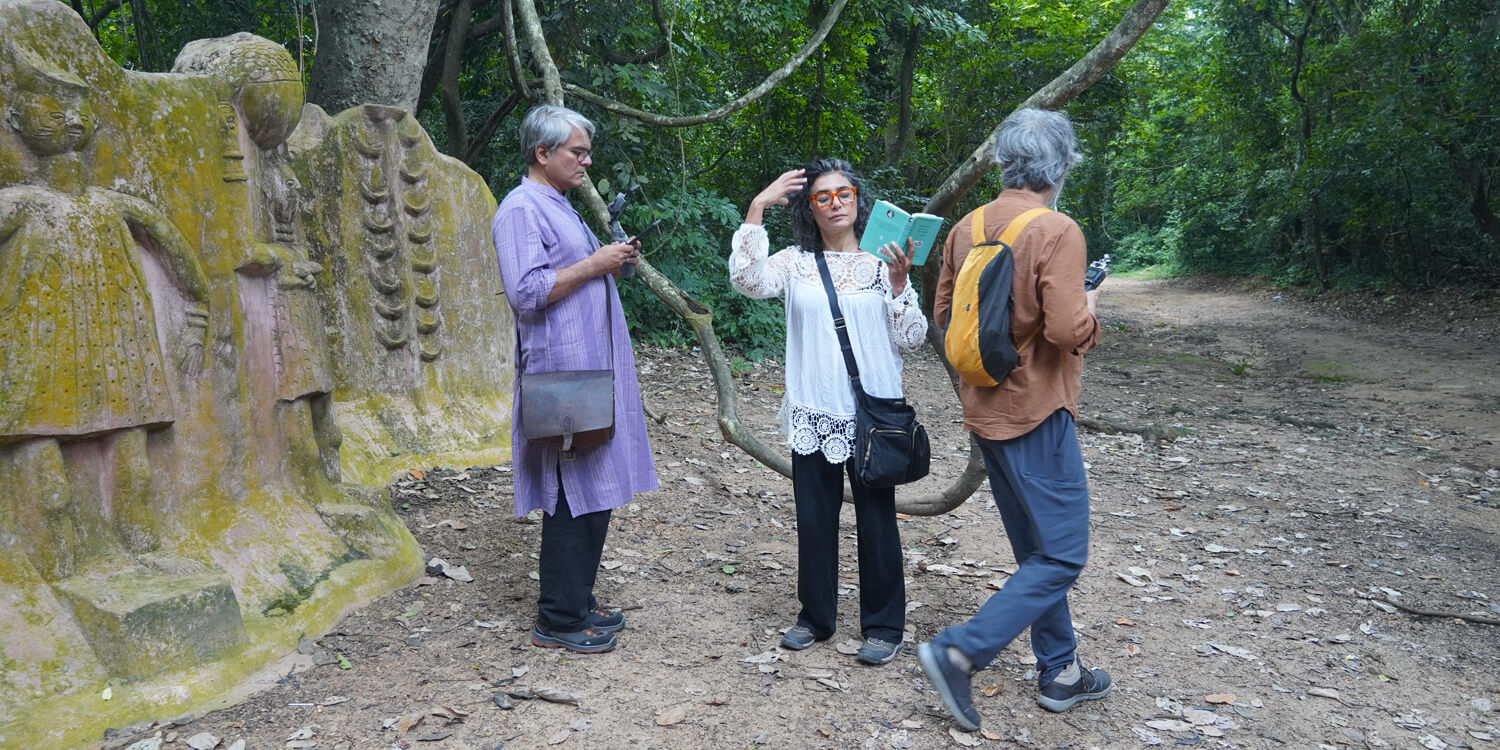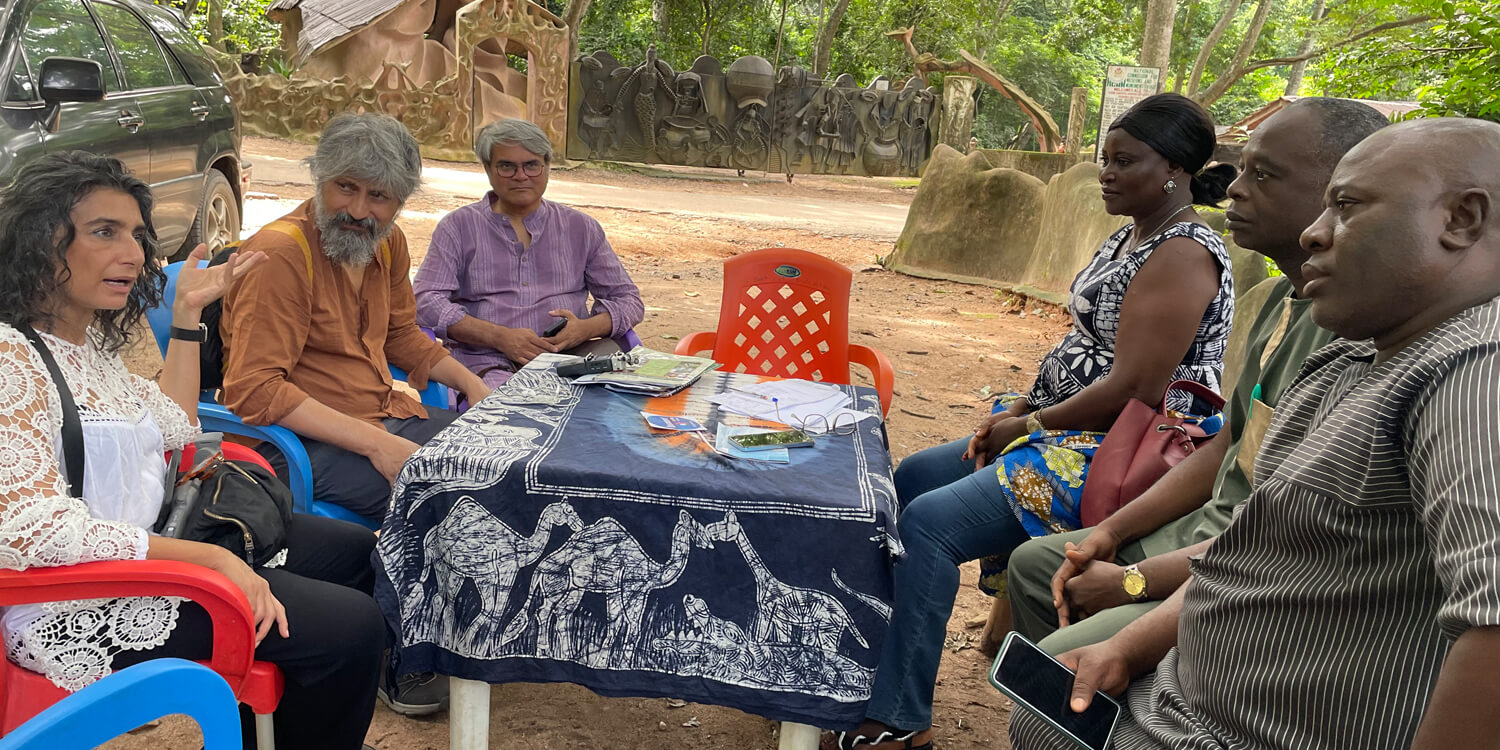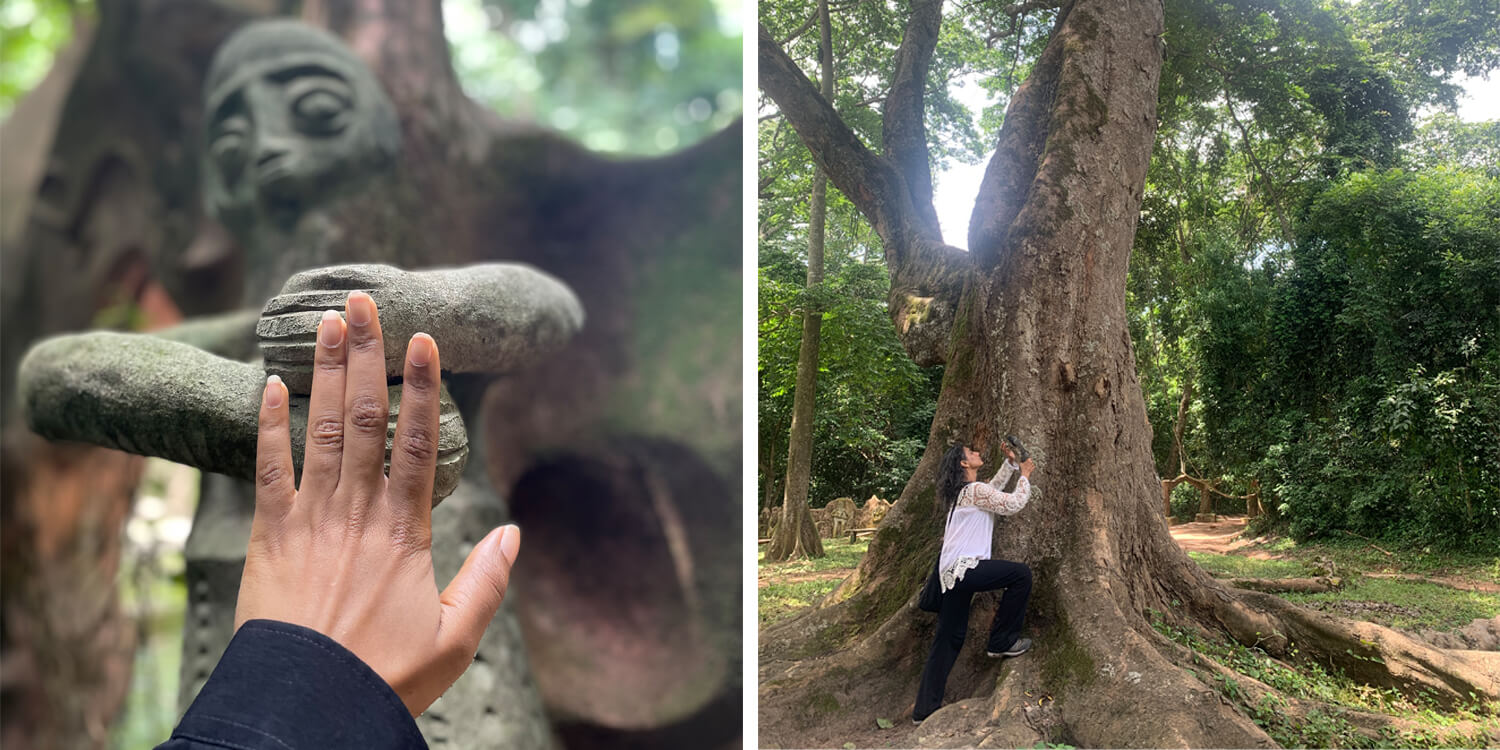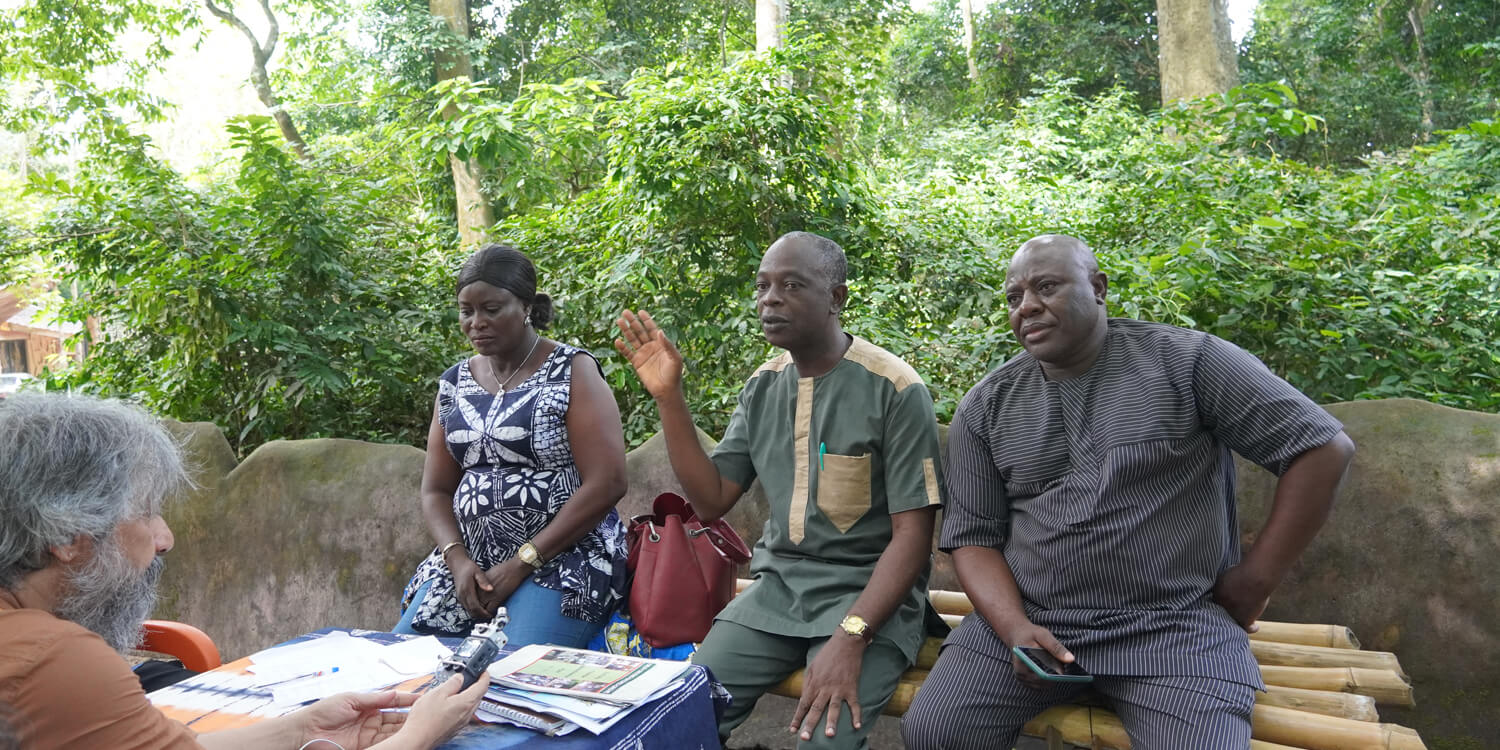A World Weather Network Report written by Raqs Media Collective
In the Autumn of 2022 and the Summer of 2023, we spent time at the Guest Artists Space (G.A.S.) Foundation residency buildings in Lagos, Nigeria, and at the G.A.S. Farm House on the Ecology Green Farm in Ikise (Ogun State). From this base, we were able to conduct in-depth research trips to the nearby Osun-Osogbo Sacred Grove in Osun State. While here, we researched and recorded material for a new artwork that can be read as our ‘weather report’ to the World Weather Network. Here is a kind of meta-narrative of this piece, a note that contextualises the work and its impulses.
Our artwork, titled ‘Na-Bam : Measure without Measure’ started in India, with another axis, which involved shooting and recording across the 28 Degree North Parallel Longitude, in North Eastern India (along the river Teesta in Sikkim, in North Western India (along the River Indus in Ladakh) and in Western India (the desert landscape of Rajasthan).
In Nigeria, we were the guests of Yinka Shonibare Foundation’s and G.A.S. Foundation’s joint World Weather Network station in Ikise, Ijebu. In India, our trips to Sikkim and Ladakh were partially supported by the WWN partner in South Asia, KHOJ, Delhi.
 From L-R Shuddhabrate Sengupta, Monica Narula and Jeebesh Bagchi at the Osun-Osogbo sacred grove.
From L-R Shuddhabrate Sengupta, Monica Narula and Jeebesh Bagchi at the Osun-Osogbo sacred grove.
The first trip to Nigeria, in the Autumn of 2022, was undertaken by Shuddhabrata Sengupta and functioned as a preliminary research and reconnaissance trip. The second trip, which followed seven months later, in June 2023, was undertaken by all three members of Raqs Media Collective, (Jeebesh Bagchi, Monica Narula & Shuddhabrata Sengupta) and involved extensive recording of video and photographic material, further research and conversations with stakeholders in the art and ecology scene in Nigeria, as well as an experiential deep dive into narratives and histories of the sacred grove in Nigeria. We would like to acknowledge the hospitality and assistance of the Guest Artist Foundation, Lagos, and their personnel, especially on the ground in Nigeria, which made our journey possible and generative.
During these journeys in Nigeria and India, our work condensed itself into a desire to think about soil and water at a planetary level and how narratives, especially mythic ones, have addressed them over time. We have always viewed environmental questions as matters that need thinking about in more than just ‘local’. Winds, temperature variations, sea-water levels and weather patterns are no respecters of national fictions. To think about the ‘weather’, which is what the World Weather Network foregrounds, we all have to adopt a perspective that girds the earth.
 Raqs Media Collective meeting with the Osun-Osogbo guides and foresters.
Raqs Media Collective meeting with the Osun-Osogbo guides and foresters.
A highlight of this almost two-year-long process has been the attainment of an experiential anchorage for our intuitive understanding of what we think of as a paradox for a thirsty planet.
‘There is both too much, and too little water. Life began in water, and without water, it will end.’
Global warming is the combination of rising sea levels (as polar ice caps melt) and lowering groundwater tables due to increased evaporation and decreasing rainfall, in the wake of rising temperatures.
Icecaps melt, forest fires rage, the air thickens, the climate changes, and we learn to think a lot of very old things anew. How much to eat, how much to drink, how much to grow, how much to throw.
Troubled rivers, a thirsty well, a forest in rain, earthworms, thoughtful monkeys, foragers, fishermen and goddesses - everything and everyone watches the weather turning.
 (L) One of the sculptures at the Osun-Osogbo sacred grove and (R) Monica Narula with one of the ancient trees at the grove.
(L) One of the sculptures at the Osun-Osogbo sacred grove and (R) Monica Narula with one of the ancient trees at the grove.
In Nigeria, we found that the dynamic of terrestrial living processes manifests in the state and quality of topsoil. A virgin forest, like that of the Osun-Osogbo sacred grove, takes thousands, if not millions of years, to nurture a topsoil, with the help of falling leaves, rainfall, micro-organisms, fungi and earthworms. When a forest is cleared overnight, this rich biome is eradicated, almost overnight.
The sacred grove is that part of a forest that is protected from clearing by a story. That story is its talisman. In Osun, this is the story of a wandering chieftain who comes upon a beautiful river in a dense forest. Then the goddess Osun appears to him and tells him that if he promises not to cut a single leaf in the forest, or take a fish from the river, she will protect him and his people.
The dense forest of the Osun Sacred Grove, on the outskirts of the city of Osogbo, is one of the last remnants of primary high forest in southern Nigeria. Regarded as the abode of the goddess of fertility Osun, one of the pantheon of Yoruba gods, the landscape of the grove and its meandering river is dotted with sanctuaries and shrines, sculptures and artworks in honour of Osun and other deities. The sacred grove, which is now seen as a symbol of identity for all Yoruba people, is probably the last in Yoruba culture. It testifies to the once-widespread practice of establishing sacred groves outside all settlements. And so, for hundreds of years, the Yoruba have held to their promise, and the forest still thrives.
 Raqs Media Collective conducting research interviews with local residents.
Raqs Media Collective conducting research interviews with local residents.
In both autumn and summer, we witnessed small groups of pilgrims entering the grove, performing sacrifices and leaving offerings. Their ceremonies have a simplicity and a lack of ostentation. The Osun River runs cloudy in the rainy season, but in the summer, its water is normally crystal clear, such that fishermen can see fish right down to the riverbed.
But in the summer of 2020, the water of the Osun River stayed cloudy, almost the colour of tea. Fishermen could no longer see fish unless they were dead and floating belly up. Something had gone wrong. The river, also the Goddess Osun, was opaque.
What had happened was this: two years prior, a mining company in the area, the Segilola Resources Operating Limited (SROL) had been bought up by Thor Explorations Limited, a Canada-based mining company. Thor Explorations had begun prospecting, and then extensible mining, for gold in the Osun River Basin. Gold is not the only mineral resource in and around Osun. There is also cassiterite, columbite, tourmaline mica and marble.
Alluvial gold deposits were found in the Osun River system as far back as 1945. But until recently, the only mining activity that took place along Osun was artisanal. Industrial mining came into the picture in 1980, and by 2017 Thor acquired mining lease ML41 (about 27sq km or 10.4 sq miles), and three exploration licenses. Alluvial Gold Mining leads to residues and traces of Arsenic entering the water system. Once drunk, it inevitably leads to a kind of arsenic poisoning. It is believed that more than 400 children died in a Bagega community by the Osun River on being exposed to polluted water as a result of gold mining. Levels of arsenic and mercury in the water were found to be 850% and more than 2,000% respectively above the permissible level.
Had the sudden lust for gold succeeded in invoking Osun’s wrath, and a withdrawal of her protection?
In our journeys in India and Nigeria, we figured out that to be thirsty is to immediately understand the limits of the body and the planet. Every structure that human beings build - home, refuge or shelter - has to make room for the means of quenching thirst. It is possible to live in a house without a kitchen, but not in a place where there are no means to store water. And you cannot breathe unaided in water for more than a few minutes at a time. To have water enter your lungs through the breath is to risk drowning on the inside. To make room for water is to make room for life itself.
Our notes from our journeys along rivers and in forests made their way into the ‘weather report’ we made.
Here is an extract:
“Everything alive thirsts. How to calibrate thirst, how to measure deluge?
Fishermen talk of water in some places as na-bam, where depth has no measure. Their extended bamboo measuring sticks, called ‘bam’, don't touch land. Some call it ‘Measure without Measure’.
When the ocean waters will rise in tandem with temperature, there will be flood, an abundance of water. There will also be thirst. It will be na-bam.n Eventually, that measure evaporates. Deserts wait for rain. Farms and forests mourn its excess. What stories will river-goddesses tell then?
Land. River. Sea. Storm. Scared. Rain. Forest. Thirst. Profane. Harvest.
Measures without measure.”
Our journeys showed us that there are tides, currents and deltas under our skin. The architecture of the human body takes into account the fact that 60% of us is water. The body is a deep well. A strong, healthy body can stretch itself to live for close to three weeks without food, but without water, we would be dead in three days. On the other hand, to be surrounded by water more than one needs to be is to risk drowning.
Over the past two years, we have watched, listened, learnt. We have tried to think with wells and rivers. We have returned to riverbanks, wells and a forest.
Without irrigation, rivers and rainfall, nothing would grow in farms or forests. The rest of our food comes from rivers, lakes and oceans. The things we eat either need water to thrive or live in water. And whatever we drink to quench our thirst is mainly water. Without water, we would neither eat nor drink. We swim in water before we are born. We thirst for it in our final moments. The swimming, the thirst, cannot be measured.
Our work for the World Weather Network, ‘Measure without Measure’ has been a humid meditation on the conditions that make life.
Written by Raqs Media Collective.
Header image credit: The Osun River, 2023. Image courtesy of Raqs Media Collective.
-------
ABOUT RAQS MEDIA COLLECTIVE
Raqs Media Collective (Jeebesh Bagchi, Monica Narula, Shuddhabrata Sengupta) are variously described as artists, media practitioners, curators, researchers, editors and catalysts of cultural processes. Their work is located at the intersections of contemporary art, historical enquiry, philosophical speculation, research and theory, often taking the form of installations, online and offline media objects, performances and encounters.
ABOUT THE WORLD WEATHER NETWORK
The World Weather Network, a constellation of weather stations set up by 28 arts agencies around the world formed in response to the climate crisis. From June 21 2022 to June 21 2024, artists, writers and communities will share observations, stories, reflections and images about their local weather, creating an archipelago of voices and viewpoints. Engaging climate scientists and environmentalists, the World Weather Network brings together diverse world views and different ways of understanding the weather across multiple localities and languages.